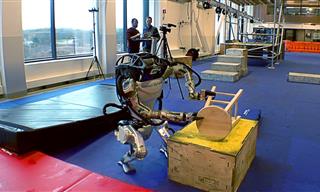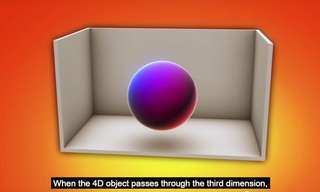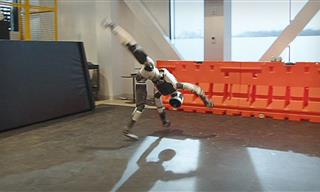

As one can imagine, this isn’t fun at all. In fact, recently, scientists have called for improved safety guidelines and better research into how these electrodes destroy brain cells, as well as how they trigger the brains’ inflammatory immune system response.
Now, researchers from Carnegie Mellon University, funded by the Department of Defense’s research wing, DARPA, may have found a way around this. They’ve developed a flexible, squishy-silicon-based hydrogel that sticks to neural tissue, bringing non-invasive electrodes to the brain’s surface.
This hydrogel, which was tested on a cat’s dorsal root ganglion – a cluster of spinal nerve cells – can conform and adhere to cells. This lets the enclosed electrodes record brain activity without actually exposing the brain to the electrodes.
The researchers are hoping that their work will lead to a new era of safer neural implants, while also giving rise to better, more accurate neural readings that could help us better understand diseases and other brain conditions.
In a press release, Chris Bettinger, a Carnegie Mellon University engineer who worked on the hydrogel said: “Imagine you have a bowl of Jell-O, and you insert a rigid plastic fork into the bowl and move it around.” This is what it’s like when a conventional electrode is inserted into the brain.

While this is an over exaggeration, electrodes do cause a tiny amount of structural damage on their way down through the cortex. While scientists are still split on whether or not the adult human brain can grow new cells, it’s probably best to minimize the number of holes that you drill into it.
Furthermore, the brain knows that electrodes don’t belong there, so it calls on the immune system to fight them off. This leads to the eventual degradation of electrodes, meaning they give off inaccurate cell recordings and hamper neuroscientific research. Since the hydrogel can pass as brain-like, the body is much less likely to try to fight it off.
It’s far too early to say exactly how this new neural implant hydrogel will affect the realm of medical neuroscience, but if human trials work as well as the experiments on cats, then the brain-computer interfaces of the future could become much more seamless and a lot less harmful.
Source: futurism
Images: depositphotos
 11:58
11:58
Myths in Medicine and Health That We MUST Stop Believing
In this video, Dr. Seema Yasmin helps debunk (and confirm) some common myths about medicine and health.

This Is What’s Currently Known About COVID-19 Immunity
We now know for certain that recovering Covid-19 patients possess antibodies for the illness. What does that mean regarding their immunity for reinfection?

6 Nutrition Tips From Experts to Ensure Better Sleep
Making a few tweaks in your eating habits could do wonders for the quality of your sleep, according to experts.

7 Tips For How to Remember Everything You Read
This article will provide you with 7 tips on how to remember everything you learn from any source.
 5:04
5:04
Ever Wondered How Hormones Work? Well, Wonder No More...
Ever wondered how hormones work? Well, wonder no more as this informative TED-Ed video explains all!

How To Take Control Of Your Wellbeing Through Breathing
Breathing seems obvious to most of us, but there is an art to it. Becoming conscious of your breathing could greatly benefit your mental and physical health.

Remembering the Life and Wisdom of Stephen Hawking
Stephen Hawking possessed one of the greatest minds the world has ever seen, but was also impaired by a debilitating disease. Here are his life ant times.
 15:34
15:34
This Stunning Video Visualizes the Size of the Universe
This video visualizes the number of galaxies in the world, giving you a look into the true size of our enormous universe.

10 Declassified U.S. Military Secrets That'll Astound You
Government military secrets can range from amusing to absurd to downright terrifying, but they are all extremely intriguing. Here are 10 such secrets.
 1:48
1:48
Boston Dynamic's Robot Does Some Incredible Things...
Boston Dynamics shows us again what her lead robot can do.
 9:34
9:34
Was Roman Concrete Really Superior to Our Own?
How did Ancient Romans make such durable concrete that it still lasts today?
 2:03:03
2:03:03
Full Documentary: From First to Last Dinosaur
With stunning visuals and cutting-edge science, we’ll bring their story to life—from their very first day to their last, a saga of survival, adaptation, and mystery.

6 Harmful Toxins You Didn’t Know You Encounter Daily
These toxic chemicals can be found in everyday products and can be extremely dangerous to us.

This New Blood Pressure Drug Could Be a Game-Changer
Zilebesiran, an investigational drug that is showing profound success in late-stage clinical trials is offering hope for millions who struggle to keep their blood pressure in check.
 15:41
15:41
Keep Your Home Safe with These Handy Gadgets
These 13 devices will transform your home security.
 1:29
1:29
A Must See: White Cells Devouring Bad Bacteria!
A real look at how white cells identify and consume harmful bacteria.

Has Modern Technology Changed Our Cognitive Abilities?
Modern digital technology is everywhere and it’s changing how we think, how we behave and even how we feel about things.

12 Steps That Help to Explain Einstein's Famous Theory
Have you ever wondered what Einstein's Theory of Relativity is all about? If you have, here is an easy-to-understand explanation!
 4:49
4:49
This Video Shows You a Different Way to Look at the World
You’ve heard of the fourth dimension but do you know what it is? This TED-Ed video helps uncover a bit of the mystery.

Earth Is So Incredible: I Was Stunned by These 50 Facts
Here's a post that will explain to you just what's truly, scientifically amazing about our planet Earth. I'm gobsmacked.

Extraordinary Inventions By Tesla That Were Never Built!
Nikola Tesla was a scientist too advanced for his time. Here are some of the inventions he never had a chance to build.
 11:02
11:02
Ever Wonder What Ancient Egyptian Sounded Like?
Researchers have used all the information we know to create what they think it may have sounded like.
 10:30
10:30
China's Crazy Plan to Dig a Canal in the Middle of EUROPE
China is setting out a plan to dig a canal through the middle of Europe in the nearest future, but why?
 6:25
6:25
Do You Like the Smell of Rain? This Is Why
One of the best things about rain and thunderstorms is that clean fresh smell afterward. But what actually causes that distinct scent?
 16:26
16:26
Neanderthals Had Strength and Skills Beyond Our Limits
Neanderthals possessed truly exceptional, almost unbelievable, traits.

10 Tech Products You Must Double-Check Before Buying
Beware! These tech products are most commonly faked.
 20:32
20:32
History: Did the Trojan War REALLY Happen?
The Trojan War, the most famous of the ancient wars, fought by thousands of men for ten long years on the beaches of the famed city of Troy. Was all that real?
 3:55
3:55
50 Years Later, We're Debunking the Moon Landing "Hoax"
How do we prove to people the moon landing was real? By answering their doubtful questions in this video.

Will We Ever Solve Our Universe's Most Complex Mysteries?
Here are 8 of the biggest unsolved mysteries from the world of physics.

Science in 2025: 8 Developments That Could Change it All
Here are some of the most exciting trends in science and healthcare to keep an eye on.
 3:07
3:07
The Speed of Light Visualized in a Magnificent Video
Have you got the patience? Watch, in scale, just how long it takes light to travel from Earth to Mars
 1:08
1:08
Boston Dynamics New Robot Can Move Almost Like a Human
Watch the latest in robotics in this video.
 1:44
1:44
You Won't Believe What the Human Body Does in One Minute
How much do you think it is capable of doing in a single minute? Watch this video and you'll have your answer!
 2:11
2:11
Here are Some Unique Tricks You Can Do at Home With Salt!
This video shows us a few interesting magic tricks that you can do anytime using salt, ice, and other items you can find at home.
 11:43
11:43
Learn While Laughing: The Incredible Tardigrade
If you love nature and you love laughing, this incredible series of nature videos are a great way to spend a few minutes.

Science Proves: These 10 Bible Stories Probably Did Happen
The Bible describes many seemingly supernatural cases, but today, science can show that they might have indeed happened.
 8:19
8:19
You Won't Believe What Passes for a Phone in North Korea
You won't believe what phones look like in North Korea!
 42:14
42:14
Physicist Michio Kaku: The Universe in a Nutshell...
Physicist Michio Kaku explains the fundamental nature of our universe
 10:31
10:31
Science Predicts These 10 Technologies Will Rule 2025
These upcoming tech innovations will reshape our world.

Science News: AI-Designed Drugs Move to Human Trials
Isomorphic Labs, is positioning itself to begin human clinical trials of medications designed entirely through artificial intelligence, marking a potentially transformative shift in how we develop life-saving treatments.
 8:48
8:48
Fascinating: What Around Us is Invisible?
The Invisible Things that Turn the World...
 8:10
8:10
Taller Doesn't Mean Bigger - the True Size of Skyscrapers
If you were to compare skyscrapers by area rather than height, which skyscraper would end up on top?

I Bet You Didn't Have a Clue About These Human Body Facts!
The human body is the most complex machine known to mankind, but I bet you don't know these 10 amazing facts about it...
 8:11
8:11
Fascinating: What is the Deepest Hole Humanity Has Dug?
This video explains how low humanity has dug down so far.

6 Signs That Someone is Listening on Your Cellphone Calls!
With technology advancing all the time, there is the ever-increasing chance of our phones being tapped. Here are 6 signs that your phone could be tapped.
 16:31
16:31
Why Building a Perpetual Motion Machine Is Impossible
Since the Middle Ages, scholars have been trying to build the mythical perpetual motion machine. Was it all in vain? Is it even possible to build such a machine?
 11:05
11:05
Science: Can AI Preserve Our Most Precious Memories?
Technologist Pau Aleikum Garcia talks about synthetic memories.
To enable your Ad-Free Subscription, please fill the fields below
Your subscription was successful, now you can enjoy an ad-free experience!! Note: To make sure you get no ads, please make sure to log in to your account. If you are logged in already, then refresh the page. The subscription can be cancelled at any time.


